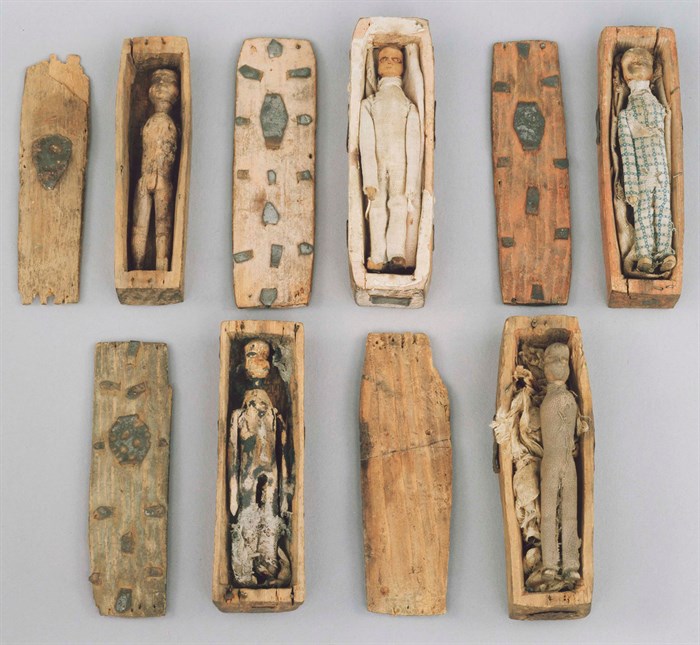Tags
allen simpson, body snatchers, christina couper, jeff nisbet, resurrection man, robert frazier, samuel menefee
Edinburgh, Scotland is home of many paranormal anomalies and stories. One emerged on July 16, 1836, regarding 17 miniature coffins found tucked into a gap near Arthur’s Seat, one of 4 hills within Holyrood Park. The story goes…
On June 25, 1836, “a number of boys” (later evolving into 2-5) were hunting rabbits and searching for burrows. The lot of them spied 3 slatestones (or was it that one boy fell through a crag?) discovering 17 miniature coffins complete with little figures tucked inside.
Measuring no more than 4 inches in length, the Scot pine wooden coffins held male figures wrapped in fabric. The tale states that there were 3 tiers of coffins, two with 8 and the top one with 1, in all. The boys collected the coffins and decided to play toss, destroying all but 8.
The brief entry in The Scotsman proclaimed the figures the work of a “satanic spell-manufactory” whereby witches cast “spells of death by entombing the likeness of those they wish to destroy.”
Supposedly, at some point, the boys gave the relics to Mr. Ferguson, their headmaster, who was also a member of the local archaeological society. Imagine their great fortune! The headmaster passed the figurines to Robert Frazier, a South Andrews Street jeweler, who had his own private museum. The collection was auctioned off in 1845, after his retirement/death, for £4. Ultimately, the 8 remaining dolls ended up with Christina Couper of Dumfriesshire, who donated them to the National Museum of Scotland in 1901.
The story is a bit sketchy. However, there is much mystery still surrounding the figures.
Little was published about the find in Scotland. It didn’t garner any media in the US. In 1994, researchers Allen Simpson and Samuel Menefee examined the figures and coffins and published their findings.
On October 31, 2018, the museum tweeted out various images of the figures and provided some context.


Simpson and Menefee believed that one person was responsible for carving the male figures. They argued that up to 2 people could have made the coffins. They surmised that the figures were toy soldiers, most notably because corpses don’t have their eyes open. They theorized that the artist(s) were not skilled woodcarvers as they lacked the tools to refine the carvings. After examining the accompanying decorations, Simpson and Menefee felt that the figures were created/assembled by a shoemaker or a cobbler.
Simpson and Menefee dated the figures to between 1800-1830. Recent researchers have narrowed the window to 1830, based on the fabric clothing adorning each male.
No one knows why the figures were created. However, several theories have been pursued. The initial one published in The Scotsman of witchcraft was quickly dismissed. Scholars and practitioners pointed out that tiny figures were never part of ritualistic magic.
Next was the possibility put forth by the Caledonian Mercury, that this was a memorial to deceased sailors. The theory only holds if there was a single tragedy that claimed the lives of 17 men. No such incident has ever been discovered.
The Edinburgh Evening Post printed that this was an “ancient custom…burying in effigy departed friends who…died in a distant land.” There would be many, many more found if this was the case.
The most rousing theory centered on Burke and Hare, 2 infamous body snatchers who were tried for killing 16 people in order to sell their corpses to area doctors for anatomical experimentation. (Read my blog here, https://thehauntedlibrarian.com/2020/10/27/resurrection-men-body-snatching-in-the-victorian-era/.) There are several flaws in this theory. First, the figures are all male. Burke and Hare were accused of killing at least 10 females. Next, there is a dispute as to the true number of victims. Was it 16? 17? Or even more? Seems convenient that there were 17 tiny coffins which may have matched the number of victims.
The most fantastical story was again published in The Scotsman in 1906. A woman claimed that her father, a Mr. B., owned a business where a “daft” man visited holding a drawing of 3 similarly styled coffins with the dates 1837, 1838, and 1840 written underneath. After giving Mr. B. a glare, the man disappeared. Some renditions claim that the man attended the funerals of Mr. B.’s relatives who died in those years.
Solving the mystery continues. In April of 2018, amateur historian Jeff Nisbet penned an article where he proffered his theory, linking the effigies to the Radical war of 1820. He believed that the 17 coffins symbolized the local members of this political movement and the “flames of rebellion lit” from the event.


How many tiny coffins were there? In published stories, which have several facts contradicting each other, the number of coffins sits at 17. However, how do we know? The boys were never identified or interviewed. The stories claim that the boys damaged some of the coffins/figures. Who knows for sure how many that is?
Stories continue to fill news feeds as the coffins capture our imaginations. In December of 2014, the museum received a replica coffin with a label quoting a portion of Robert Louis Stevenson’s “The Body Snatcher” (1884). (Link to the story can be found here: https://robert-louis-stevenson.org/?works_post_type=the-body-snatcher-1884.)
None of this should diminish the significance of the relics. Maybe one day we will know what it all means.




You must be logged in to post a comment.